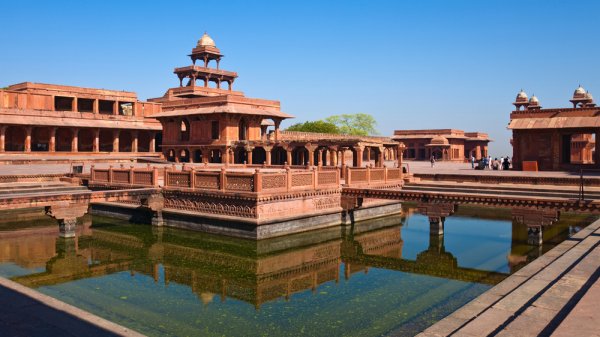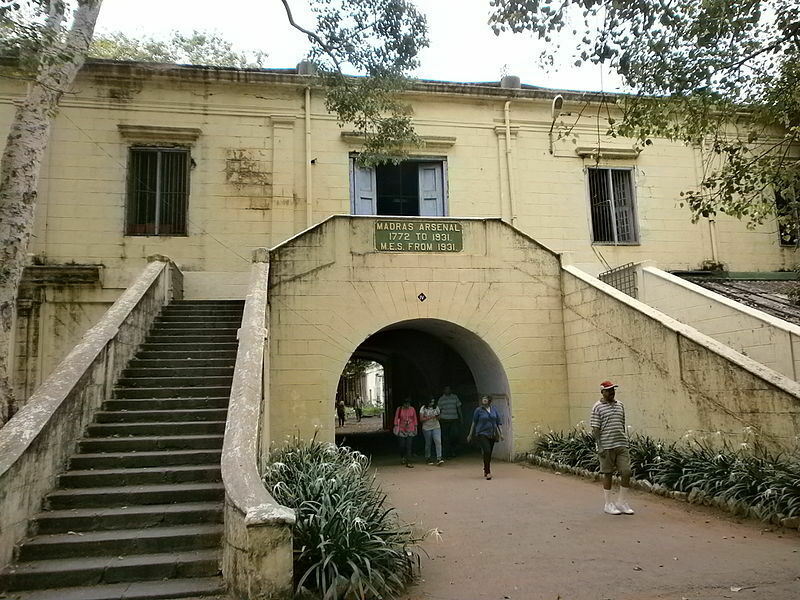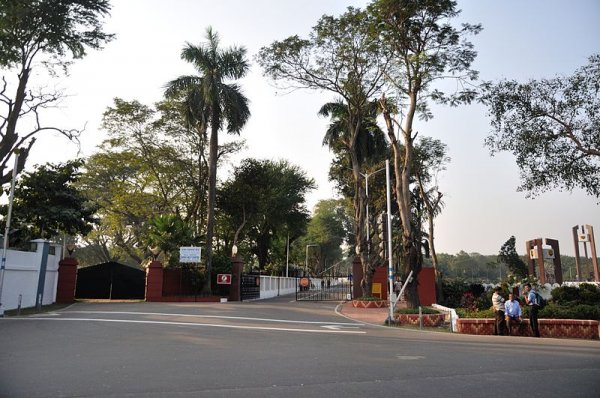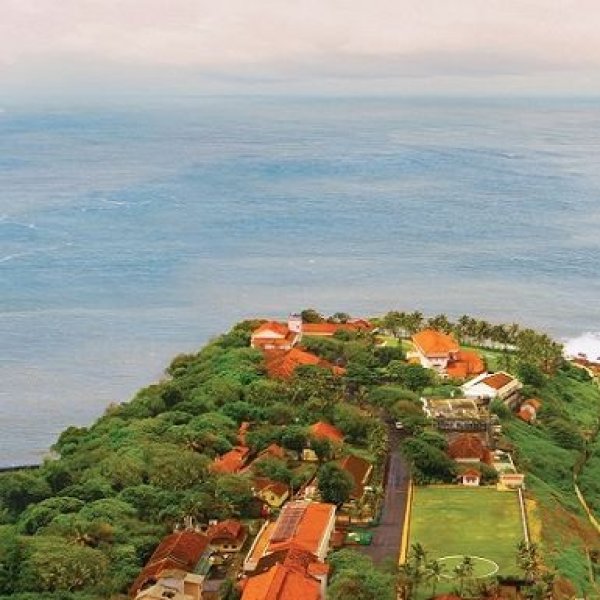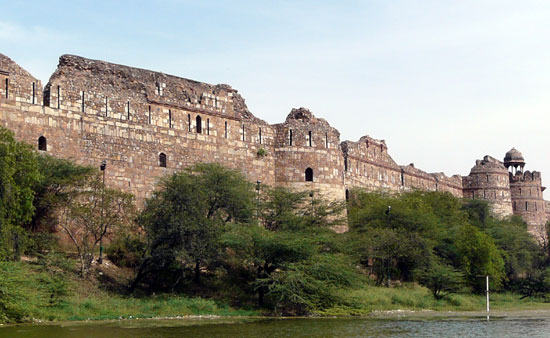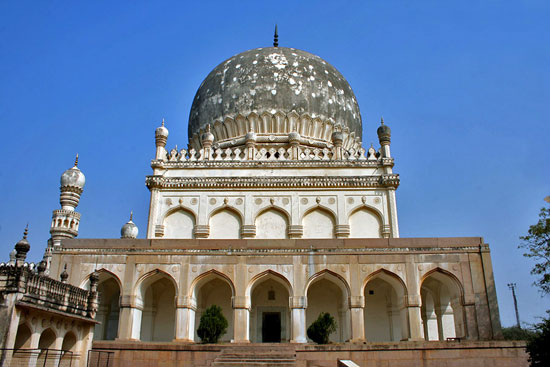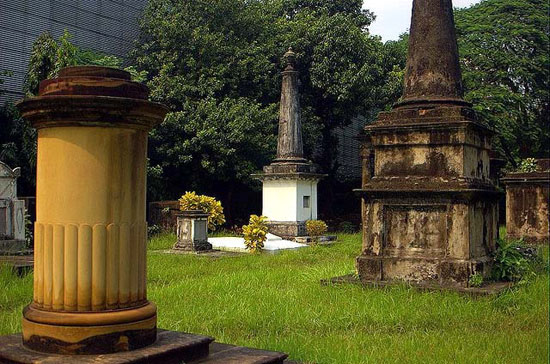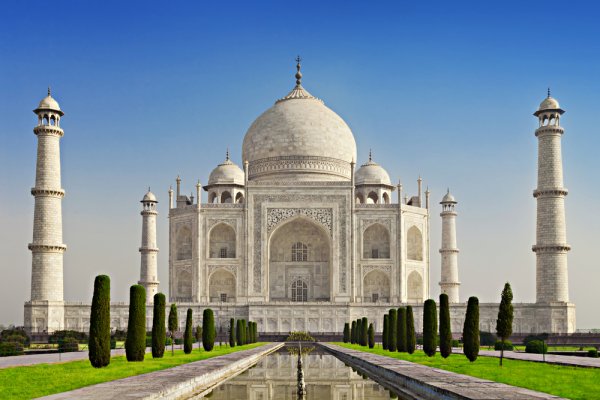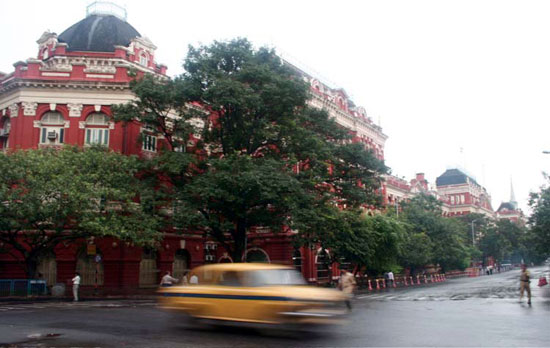Points of Interest
Fatehpur Sikri
West of Agra Agra District
Uttar Pradesh 283110, India
Fatehpur Sikri (Victory Town) is a famous historic city with architectonic Muslim motifs. It was founded around 1571 by the Mughal Emperor Akbar to honor the Sufi saint Salim Chishti, who answered Akbar's prayers with the birth of a son and heir, Jahangir. The city served as Akbar's capital until 1585, when it had to be abandoned due to inadequate water supply. Completely made of red sandstone, the complex contains the Buland Darwaza (Gate of Victory) flanked by huge statues of elephants, the Jami Masjid (Great Mosque), Panch Mahal (Five-Story Palace), palaces of Jodh Bai (Jahangir's mother) and Birbal (Akbar's chief courtier), the marble mausoleum of Salim Chishti, a massive chessboard, formal courtyards, pools, murals, and carvings.
Fort St. George
Rajaji Road, near Legislature and Secretariat
Chennai, India
Fort St. George is located on the banks of Bay of Bengal. It was built by the British East India Company in 1640 CE. The fort is believed to be the first establishment of the British in India. It is a military architecture marvel, which was erected as a trading post and later evolved to be the origin of modern Indian Army. Within its walls are Saint Mary's Church, built in 1680, the oldest Anglican church in India, and Fort Museum, with its collection of archaeological relics as well as memorabilia from the periods of British, French, Raj and Muslim rule. It has the tallest flagpole in India. This beautiful building has stood the test of time and includes wall frescos and teak plaques.
– Information provided by Chennai.com
Fort William
The Maidan
Kolkata, India
The original Fort William was built on the eastern banks of the Hooghly in 1701–1706 by the British East India Company during their bloody expansion into the Subcontinent. After the Black Hole of Calcutta incident in 1756, Robert Clive ("of India") began constructing the new Fort William in a Vauban-influenced design, shaped as an irregular octagon to defend against artillery fire. This was a fashionable design blueprint of the time, with similar buildings commissioned in Kerala, Rajasthan, and the Punjab. It was and still is encircled by a deep, waterless moat, and possesses six gates. Although still visible through the smog from many points in downtown Kolkata, the fort is now the headquarters of an Indian Army-controlled zone and therefore off-limits to the general public.
Gandhi Smriti
Tees January Marg
New Delhi, India
Gandhi Smriti, a handsome and low-slung white house on a quiet New Delhi street, is where Mahatma Gandhi was assassinated in 1948. It is now a museum dedicated to the Indian spiritual and political leader. In 1948, the house belonged to industrialist G. D. Birla, and Gandhi stayed here for a few months as his guest. A permanent flame marks the spot in the back garden where the Indian leader fell, reportedly uttering, "He ram" (O God) as his final words. Exhibits, dioramas, and multiple documentaries tell the story of Gandhi's life, from his early training as a lawyer to his national campaign of ahimsa (nonviolence) against the British imperial occupation. Gandhi's spartan bedroom is presented in the exact condition that he left it, containing a mere 11 worldly possessions, including his glasses and walking stick.
Golkonda Fort Complex
Opposite Army Headquarters
Golkonda, Hyderabad, India
The Qutub civilization was to India what the Romans were to Western culture. Their ancient capital had its finest days during the early Middle Ages, and the most enduring relic from that time is the Golkonda Fort complex. You can tour it and take in dozens of defensive towers (some still armed with cannons), mosques, armories, temples, barracks, harems, stables, royal quarters, and giant elephant-stopping spikes. Perhaps the highlight here is the astonishing acoustics that allow you to hear noises made in the dome of one of the forts almost a kilometer away—a real feat of Qutub design ingenuity. These defenses were built to last, repelling thousands of Moghul invaders for almost two centuries.
Hauz Khas Village
Aurobindo Marg
South Delhi, New Delhi, India
High fashion and history exist side by side in this plush South Delhi suburb. Now home to some of the capital's wealthiest families, Hauz Khas occupies the site of Siri, the second in Delhi's long archaeological progression of cities. Originally developed by Sultan Alauddin Khilji, Hauz Khas was notable for the huge water tank built as a reservoir for Siri. Although the water is long gone and the location now houses a shiny collection of restaurants and clothing boutiques, there's still plenty of history dotting this urban village. Look out for the Nili Masjid (Blue Mosque), the 14th-century tomb of Feroz Shah, as well as the grisly Chor Minar (Tower of Thieves). The stone walls of this minaret are still studded with more than 200 openings, to be used not as windows, but to hold the severed heads of robbers.
Pune Government House
Ganeshkhind
Pune, India
With its whitewashed walls, sun house-like canopies, and modest vibe, this may not seem like the city's official government house and governor's residence, but indeed it is. It was here that the British governors of Bombay used to work out political policies and military strategy. An early blow in the struggle for independence was struck when the Chapheker Brothers attacked the much-reviled British colonial administrator, Walter Charles Rand, as he left the building on June 22, 1897. It is perhaps apt, then, that these days Raj Bhavan comes alive each year during the official August 15 Indian Independence Day celebrations. At the time of writing you can't tour the interior of Raj Bhavan, but its exterior is well worth a look and a snapshot or two.
Purana Qila
Mathura Road and Bhairon Marg
New Delhi, India
Three gateways lead into Purana Qila, the Old Fort built by Humayun. The Moghul Emperor started construction of the red sandstone fortress, but it was his Afghan adversary Sher Shah who completed building work, after he defeated Humayun. Once the Moghul Emperor had re-imposed his rule on India, he returned to Purana Qila, turning his enemy's octagonal tower, Sher Mandal, into his personal library. The building would later become his deathtrap. When the devout Humayun heard the call to prayer, he hurried too quickly down the stone stairs, catching his foot in his robe and falling. He cracked his head on the steps and died of his injuries three days later. Along with its architectural importance, Purana Qila has archaeological fame-many believe that beneath the massive fortifications lies the ancient site of Indraprastha, the city mentioned in the ancient Indian epic, the Mahabharata.
Qutub Shahi Tombs
Near Jaihind Nagar Colony
Hyderabad, India
Just a few kilometers (miles) north of the glory of Golkonda is a tomb complex where the powerful rulers of that civilization are buried. The galleries of the tombs tend to be double-floored, with a main sarcophagus located inside. The pointed arches and picturesque onion domes are visible from a mile away and draw upon Pathan, Hindu, and Persian forms. The first restoration took place in the 19th century, when a delightful garden was landscaped around the tombs. The second restoration occurred in 2010 and proved to be more controversial, with damage being done to the attraction by untrained workers using power tools. Thankfully there's still plenty of great interest to see here, though.
Red Fort
Agra Fort About 2.5 km northwest of the Taj Mahal Rakabganj Agra
Uttar Pradesh 282001, India
Agra Fort, also known as the Lal Qil'ah (Red Fort) of Agra, was built by the Mughals during 1565-1571 and served as the royal palace for many Mughal emperors until the mid-18th century. This crescent fort comprises many structures featuring Islamic, Hindu, Persian, and Central Asian architectural styles and largely made of red sandstone and white marble. The main features include double walls towering 21 meters (69 feet) in height and spread over a 2.5-kilometer (1.5 miles) perimeter, the Amar Singh Gate, Delhi Gate, Jehangiri Mahal, Khas Mahal (Private Palace), Sheesh Mahal (Glass Palace), Diwan-i-Khas, Diwan-i-Am, Nagina Masjid (Gem Mosque), Moti Masjid (Pearl Mosque), Meena Bazaar, animal and floral motifs, carvings, and verandas.
South Park Street Cemetery
Corner of Park Street and AJC Bose Road
Chowringhee, Kolkata, India
Don't be put off by the slightly macabre thought of a cemetery doubling as a major tourist attraction. Reclaimed from swampland in the 1760s, this place is remarkable for its scaled-down city of ornate crypts and headstones belonging to such Raj-era luminaries as the botanist Charles Kydd, the Anglo-Indian poet Henry Louis Vivian Derozio, and Sir William Jones, founder of the Asiatic Society. The surroundings are lush and fragrant semi-jungle, and count as one of smoggy Kolkata's "lungs" along with Central Park and the Maidan. Visitors are encouraged to make a small donation or purchase a guidebook from the security guard at the gate.
Taj Mahal
Across the banks of the Yamuna River Tajganj Agra, Uttar Pradesh 282001 India
Renowned as an enduring monument of love, the Taj Mahal was constructed during 1632-1653 by the Mughal Emperor Shah Jahan as a mausoleum for his favorite queen, Mumtaz Mahal. The finest example of Mughal architecture with Persian, Turkish, and Indian elements, it is made of pure white marble and adorned with gold, silver, semi-precious stones, floral patterns, sculptures, unique calligraphy, and verses from the Koran. This architectural complex also features four tall minarets, a 30-meter-tall (100 feet) red sandstone gateway, a masjid (mosque), museum, small chhatris (dome-shaped pavilions), landscaped gardens, two marble canals, fountains, and ornamental trees. The Taj Mahal attracts thousands of visitors every year.
Writers' Building
Biplabi Trailakya Sarani BBD Bagh
Kolkata, India
The Writers' Building's contemporary function as the nucleus of civil service bureaucracy belies its intriguing past, for it was here in 1930 that three independence fighters, Binoy, Badal, and Dinesh, tried to assassinate Lord Dalhousie, the British Governor-General. They failed in their mission, but achieved a small victory: the name of the square surrounding the Writers' Building was changed from Dalhousie Square to BBD Square in their honor. The building's awe-inspiring Corinthian exterior was added in 1889 and, even in this post-independence age, a tattered statue of Britannia remains on the roof, perhaps deliberately as a symbol of a past that Kolkata has palpably moved on from.
Copyright © 1993—2024 World Trade Press. All rights reserved.

 India
India 